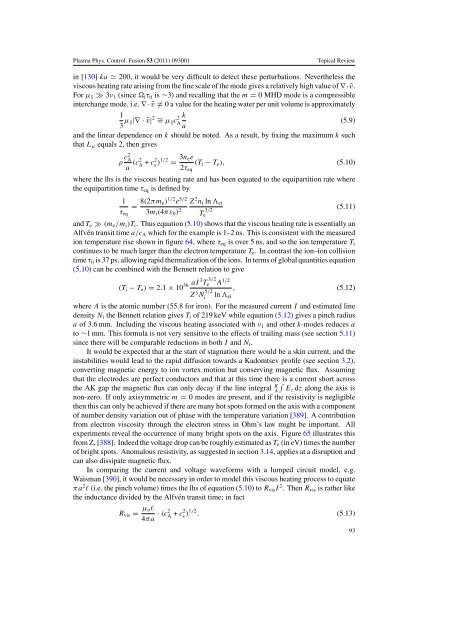You also want an ePaper? Increase the reach of your titles
YUMPU automatically turns print PDFs into web optimized ePapers that Google loves.
Plasma Phys. Control. Fusion 53 (2011) 093001<br />
Topical Review<br />
in [130] ka ≃ 200, it would be very difficult to detect <strong>the</strong>se perturbations. Never<strong>the</strong>less <strong>the</strong><br />
viscous heating rate arising from <strong>the</strong> fine scale <strong>of</strong> <strong>the</strong> mode gives a relatively high value <strong>of</strong> ∇·ṽ.<br />
For µ ‖ ≫ 3ν 1 (since i τ ii is ∼3) and recalling that <strong>the</strong> m = 0 MHD mode is a compressible<br />
interchange mode, i.e. ∇·ṽ ≠ 0 a value for <strong>the</strong> heating water per unit volume is approximately<br />
1<br />
3 µ ‖|∇ · ṽ| 2 ∼ = µ‖ cA<br />
2 k<br />
(5.9)<br />
a<br />
and <strong>the</strong> linear dependence on k should be noted. As a result, by fixing <strong>the</strong> maximum k such<br />
that L µ equals 2, <strong>the</strong>n gives<br />
ρ c2 A<br />
a (c2 A + c2 s )1/2 = 3n ee<br />
(T i − T e ), (5.10)<br />
2τ eq<br />
where <strong>the</strong> lhs is <strong>the</strong> viscous heating rate and has been equated to <strong>the</strong> equipartition rate where<br />
<strong>the</strong> equipartition time τ eq is defined by<br />
1<br />
= 8(2πm e) 1/2 e 5/2 Z 2 n i ln ei<br />
τ eq 3m i (4πε 0 ) 2<br />
T 3/2<br />
e<br />
(5.11)<br />
and T e ≫ (m e /m i )T i . Thus equation (5.10) shows that <strong>the</strong> viscous heating rate is essentially an<br />
Alfvén transit time a/c A which for <strong>the</strong> example is 1–2 ns. This is consistent with <strong>the</strong> measured<br />
ion temperature rise shown in figure 64, where τ eq is over 5 ns, and so <strong>the</strong> ion temperature T i<br />
continues to be much larger than <strong>the</strong> electron temperature T e . In contrast <strong>the</strong> ion–ion collision<br />
time τ ii is 37 ps, allowing rapid <strong>the</strong>rmalization <strong>of</strong> <strong>the</strong> ions. In terms <strong>of</strong> global quantities equation<br />
(5.10) can be combined with <strong>the</strong> Bennett relation to give<br />
(T i − T e ) = 2.1 × 10 36 aI3 Te 3/2 A 1/2<br />
Z 3 N 5/2 , (5.12)<br />
i<br />
ln ei<br />
where A is <strong>the</strong> atomic number (55.8 for iron). For <strong>the</strong> measured current I and estimated line<br />
density N i <strong>the</strong> Bennett relation gives T i <strong>of</strong> 219 keV while equation (5.12) gives a <strong>pinch</strong> radius<br />
a <strong>of</strong> 3.6 mm. Including <strong>the</strong> viscous heating associated with ν 1 and o<strong>the</strong>r k-modes reduces a<br />
to ∼1 mm. This formula is not very sensitive to <strong>the</strong> effects <strong>of</strong> trailing mass (see section 5.11)<br />
since <strong>the</strong>re will be comparable reductions in both I and N i .<br />
It would be expected that at <strong>the</strong> start <strong>of</strong> stagnation <strong>the</strong>re would be a skin current, and <strong>the</strong><br />
instabilities would lead to <strong>the</strong> rapid diffusion towards a Kadomtsev pr<strong>of</strong>ile (see section 3.2),<br />
converting magnetic energy to ion vortex motion but conserving magnetic flux. Assuming<br />
that <strong>the</strong> electrodes are perfect conductors and that at this time <strong>the</strong>re∫is a current short across<br />
<strong>the</strong> AK gap <strong>the</strong> magnetic flux can only decay if <strong>the</strong> line integral K A Ez dz along <strong>the</strong> axis is<br />
non-zero. If only axisymmetric m = 0 modes are present, and if <strong>the</strong> resistivity is negligible<br />
<strong>the</strong>n this can only be achieved if <strong>the</strong>re are many hot spots formed on <strong>the</strong> axis with a component<br />
<strong>of</strong> number density variation out <strong>of</strong> phase with <strong>the</strong> temperature variation [389]. A contribution<br />
from electron viscosity through <strong>the</strong> electron stress in Ohm’s law might be important. All<br />
experiments reveal <strong>the</strong> occurrence <strong>of</strong> many bright spots on <strong>the</strong> axis. Figure 65 illustrates this<br />
from Z, [388]. Indeed <strong>the</strong> voltage drop can be roughly estimated as T e (in eV) times <strong>the</strong> number<br />
<strong>of</strong> bright spots. Anomalous resistivity, as suggested in section 3.14, applies at a disruption and<br />
can also dissipate magnetic flux.<br />
In comparing <strong>the</strong> current and voltage waveforms with a lumped circuit model, e.g.<br />
Waisman [390], it would be necessary in order to model this viscous heating process to equate<br />
πa 2 l (i.e. <strong>the</strong> <strong>pinch</strong> volume) times <strong>the</strong> lhs <strong>of</strong> equation (5.10)toR vis I 2 . Then R vis is ra<strong>the</strong>r like<br />
<strong>the</strong> inductance divided by <strong>the</strong> Alfvén transit time; in fact<br />
R vis = µ ol<br />
4πa · (c2 A + c2 s )1/2 . (5.13)<br />
93














